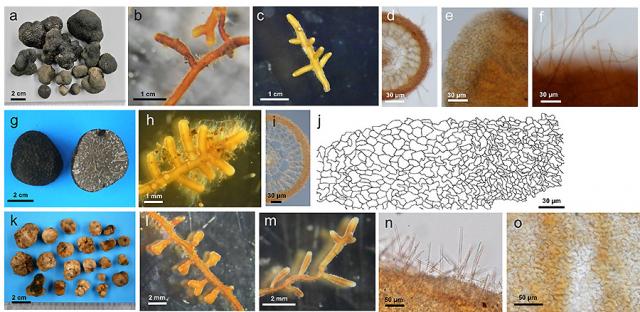Home > Research > Research Results > Research Results 2018 > Morphological characteristics of ectomycorrhizae formed by domestic truffles on Japanese oak and pine seedlings
Update:October 19, 2018
Main content starts here.
Morphological characteristics of ectomycorrhizae formed by domestic truffles on Japanese oak and pine seedlings
| Article title |
Ectomycorrhizae formed by three Japanese truffle species (Tuber japonicum, Tuber longispinosum, and Tuber himalayense) on indigenous oak and pine species |
|---|---|
| Author (affiliation) |
Akihiko Kinoshita (a), Keisuke Obase (b), Takashi Yamanaka (b) (a) Kyushu research Center, FFPRI, Kumamoto, Japan. |
| Publication Journal |
Mycorrhiza, 28(7):679-690, October 2018, DOI:10.1007/s00572-018-0860-x( External link ) |
| Content introduction |
In Europe, truffles are cultivated by inoculating roots of oak (Quercus spp.) and pine (Pinus spp.) seedlings with truffle fungi for the formation of ectomycorrhizae at the roots (Figs. b, c, h, l, and m). The seedlings are grown outdoors as truffle fungi symbiotically coexist with roots of trees and grow by obtaining nutrients from the trees. In order to successfully distinguish truffle mycorrhizae from those of other fungus species present in the soil and to assess whether truffles have successfully colonized tree roots, we need a better understanding of mycorrhizal characteristics of truffles. Presently, we are developing technology for cultivating domestic Japanese species of one white truffle (Tuber japonicum; Fig. k) and two black truffles (T. longispinosum and T. himalayense; Figs. a and g). We successfully determined suitable tree species for these truffles and characterized the morphological features of their mycorrhizae. Inoculation of the three truffles into the roots of Japanese red pine (Pinus densiflora), konara oak (Quercus serrata), sawtooth oak (Q. acutissima), and ubame oak (Q. phillyraeoides) yielded mycorrhizae for each truffle species. All truffle mycorrhizae were brown to cream in color and shared puzzle piece-shaped mycelial structures on the mycorrhizal surface (Figs. b-e, h-j, and l-o). The two black truffles had morphologically similar mycorrhizae whose hyphae extended from the mycorrhizal surface, with a characteristic of branching at right angles (Fig. f). The white truffle, T. japonicum, however, had needle-shaped hyphae of 100 µm in length extending from its mycorrhizal surface (Fig. n). We successfully formed truffle mycorrhizae on trees which are widespread throughout Japan. Therefore, truffle cultivation using those trees is feasible throughout Japan. We present photographs of mycorrhizae and details of morphology for assisting growers to determine whether inoculated truffles successfully formed mycorrhizae. |
Copyright © Forest Research and Management Organization. All rights reserved.

